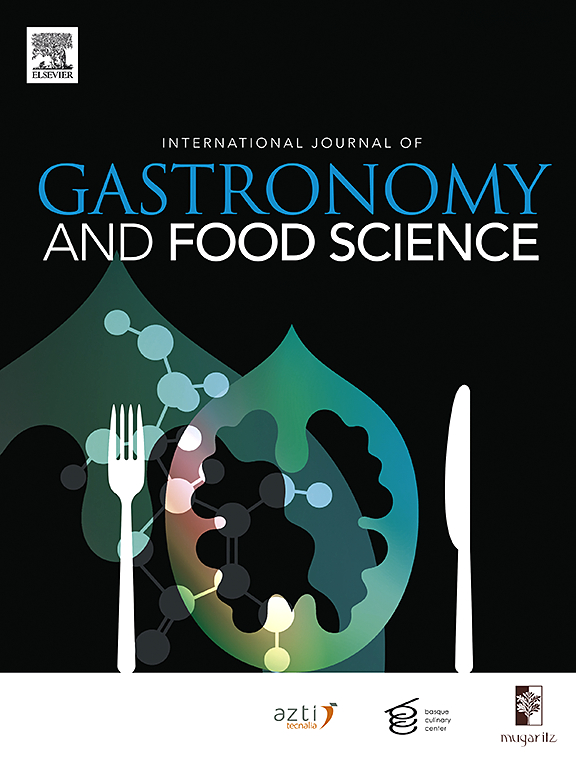发芽小黑麦粉在面包制作中可部分替代小麦粉
IF 3.6
2区 农林科学
Q2 FOOD SCIENCE & TECHNOLOGY
International Journal of Gastronomy and Food Science
Pub Date : 2025-09-26
DOI:10.1016/j.ijgfs.2025.101312
引用次数: 0
摘要
小黑麦是小麦和黑麦的杂交品种。本研究的目的是在不添加添加剂的情况下改善小麦面包的营养和功能特性,同时保持面包的质地。以100%白麦和黑麦面包(RB, 30%黑麦)为原料,生产小黑麦面包(TB, 30%小黑麦)和发芽小黑麦面包(GTB, 30%发芽小黑麦),并对其流变学、质地、抗氧化性能和风味进行了分析。TB和GTB的弹性模量(面团延伸性)低于WB。尽管用30%的小麦粉替代,但TB和GTB的特定面包体积与WB相当。TB的硬度显著低于WB和RB,而GTB和WB之间差异不显著。小黑麦面包(TB和GTB)的退化速度较慢,Avrami指数(n)值低于WB。GTB具有较好的烘烤后抗氧化性能,总酚含量高于WB和RB。电子鼻和舌头分析显示,GTB具有独特的风味特征,显示出最高的挥发性化合物水平,增强了鲜味和甜味。因此,发芽小黑麦粉在保持面包质量和质地的同时,提高了面包的营养和功能特性。因此,它是小麦粉的可持续替代品。本文章由计算机程序翻译,如有差异,请以英文原文为准。
Germinated triticale flour as sustainable partial substitute for wheat flour in bread-making
Triticale is a wheat–rye hybrid. The aim of this study was to improve the nutritional and functional properties of wheat bread (WB) while maintaining the texture without additives. Triticale bread (TB, 30 % triticale) and germinated triticale bread (GTB, 30 % germinated triticale) were produced along with 100 % WB and rye bread (RB, 30 % rye), and their rheology, texture, antioxidant properties, and flavor were analyzed. The elastic moduli (dough extensibility) was lower for TB and GTB than for WB. Despite a 30 % wheat-flour replacement, the specific loaf volumes of TB and GTB were comparable to that of WB. Hardness was significantly lower for TB than for WB and RB, whereas it did not differ significantly between GTB and WB. Triticale breads (TB and GTB) showed slower retrogradation, as evidenced by their lower Avrami index (n) values than that of WB. GTB exhibited superior post-baking antioxidant properties with higher total phenolic content than those of WB and RB. Electronic nose and tongue analyses showed distinct flavor profiles with GTB exhibiting the highest volatile compound levels and enhanced umami and sweetness. Thus, germinated triticale flour improves the nutritional and functional properties of bread while maintaining its quality and texture. Therefore, it is a sustainable alternative to wheat flour.
求助全文
通过发布文献求助,成功后即可免费获取论文全文。
去求助
来源期刊

International Journal of Gastronomy and Food Science
Social Sciences-Cultural Studies
CiteScore
5.30
自引率
10.50%
发文量
170
审稿时长
45 days
期刊介绍:
International Journal of Gastronomy and Food Science is a peer-reviewed journal that explicitly focuses on the interface of food science and gastronomy. Articles focusing only on food science will not be considered. This journal equally encourages both scientists and chefs to publish original scientific papers, review articles and original culinary works. We seek articles with clear evidence of this interaction. From a scientific perspective, this publication aims to become the home for research from the whole community of food science and gastronomy.
IJGFS explores all aspects related to the growing field of the interaction of gastronomy and food science, in areas such as food chemistry, food technology and culinary techniques, food microbiology, genetics, sensory science, neuroscience, psychology, culinary concepts, culinary trends, and gastronomic experience (all the elements that contribute to the appreciation and enjoyment of the meal. Also relevant is research on science-based educational programs in gastronomy, anthropology, gastronomic history and food sociology. All these areas of knowledge are crucial to gastronomy, as they contribute to a better understanding of this broad term and its practical implications for science and society.
 求助内容:
求助内容: 应助结果提醒方式:
应助结果提醒方式:


